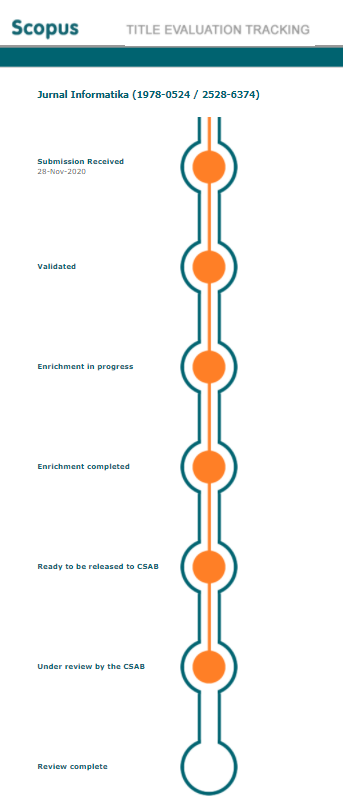Clustering based feature selection using Partitioning Around Medoids (PAM)
Abstract
Keywords
Full Text:
PDFReferences
G. Chandrashekar, F. Sahin. A survey on feature selection methods. Computers and Electrical Engineering. Vol. 40. Issue 1. January 2014. pp 16-28.
Z. Li, J. Liu, Y. Yang, X. Zhou, H. Lu. Clustering-Guided Sparse Structural Learning for Unsupervised Feature Selection. IEEE Transactions on Knowledge and Data Engineering. Vol. 26. Issue 9. September 2014. pp. 2138-2150.
R. Duda, P. Hart, and D. Stork. Pattern Recognition. 2nd ed. New York, NY, USA: Wiley, 2001.
H. Liu, X. Wu, and S. Zhang, “Feature selection using hierarchical feature clustering,†in Proc. ACM Int. Conf. Inform. Knowl. Manage., New York, NY, USA, 2011.
V.B. Canedo., N.S. Marono, A.A. Betanzos. A review of feature selection methods on synthetic data. Knowledge and Information System (2013) 34:483.
E. Alpaydin, Introduction to Machine Learning 2nd edition, MIT Press, 2006.
T.M. Cover, J.V.P. Campenhout. On the Possible Orderings in the Measurement Selection Problem. IEEE Transactions on Systems, Man, and Cybernatics. Vol. 7. Issue 9. September 1977. pp. 657-661.
X.Wang, J.Yang, X.Teng, W.Xia, R. Jensen. Feature Selection based on Rough Sets and Particle Swarm Optimization. Pattern Recognition Letters. Vol 28. Issue 4. March 2007. pp. 459-471.
C.L. Huang, C.J. Wang. A GA-based feature selection and parameters optimization. Expert Systems with Applications. Vol 31. Issue 2. August 2006. pp 231-240.
M. Ghaemi, M.R.F Derakhshi. Feature selection using Forest Optimization Algorithm. Pattern Recognition.Vol. 60. December 2016. pp. 121-129.
T.F. Cox, M.A.A. Cox. Multidimensional Scaling. London: Chapman and Hall.1994
G.J. McLachlan. Discriminant Analysis and Statistical Pattern Recognition. New York: Willey. 1992
S.T. Roweis, L.K. Saul. Nonlinear Dimensionality Reduction by Locally Linear Embedding. Science. Vol.290. December 2000. pp: 2323-2326.
UCI Machine Learning Repositories http:// http://archive.ics.uci.edu/ml/
D. Anguita, A. Ghio, L. Oneto, X. Parra and J.L.R.Ortiz. Human Activity Recognition on Smartphones using a Multiclass Hardware-Friendly Support Vector Machine. International Workshop of Ambient Assisted Living (IWAAL 2012). Vitoria-Gasteiz, Spain. Dec 2012.
D. Anguita, A. Ghio, L. Oneto, X. Parra, J.L.R.Ortiz. Energy Efficient Smartphone-Based Activity Recognition using Fixed-Point Arithmetic. Journal of Universal Computer Science. Special Issue in Ambient Assisted Living: Home Care. Volume 19. Issue 9. May 2013.
J.L.R. Ortiz, A. Ghio, X. Parra, D. Anguita, J. Cabestany, A. Catala. Human Activity and Motion Disorder Recognition: Towards Smarter Interactive Cognitive Environments. 21st European Symposium on Artificial Neural Networks, Computational Intelligence and Machine Learning, ESANN 2013. Bruges, Belgium, 24-26 April 2013.
M. van Breukelen, R.P.W. Duin, D.M.J. Tax, J.E. den Hartog, Handwritten digit recognition by combined classifiers, Kybernetika. vol. 34. no. 4. 1998. pp 381-386.
M. van Breukelen, R.P.W. Duin. Neural Network Initialization by Combined Classifiers, in: A.K. Jain, S. Venkatesh, B.C. Lovell (eds.). ICPR'98. Proc. 14th Int. Conference on Pattern Recognition (Brisbane, Aug. 16-20).1998.
DOI: http://dx.doi.org/10.26555/jifo.v14i2.a17620
Refbacks
- There are currently no refbacks.
Copyright (c) 2020 Dewi Pramudi Ismi, Murinto

This work is licensed under a Creative Commons Attribution-ShareAlike 4.0 International License.
____________________________________
JURNAL INFORMATIKA
ISSN :Â 1978-0524 (print) | 2528-6374 (online)

This work is licensed under a Creative Commons Attribution-ShareAlike 4.0 International License.






